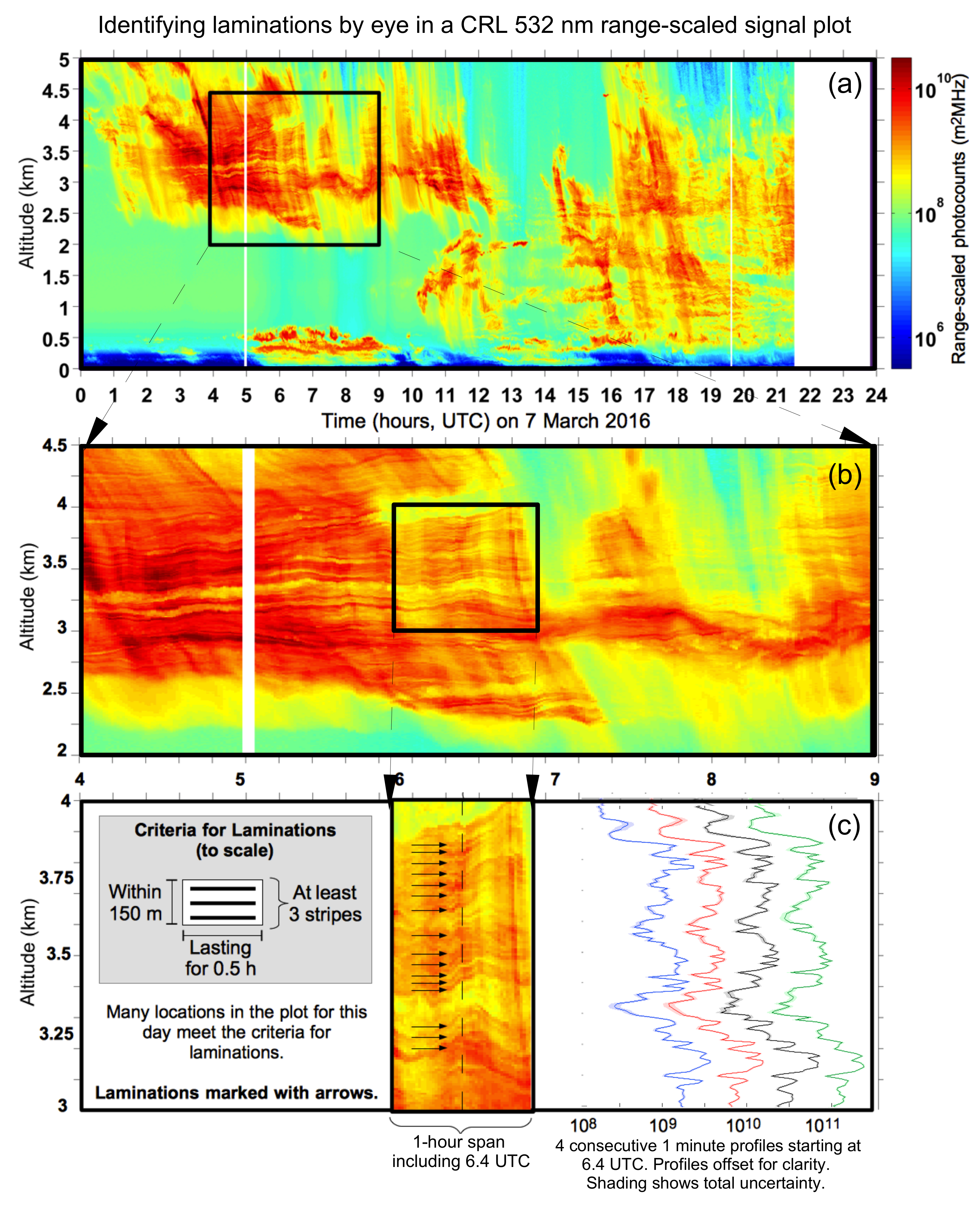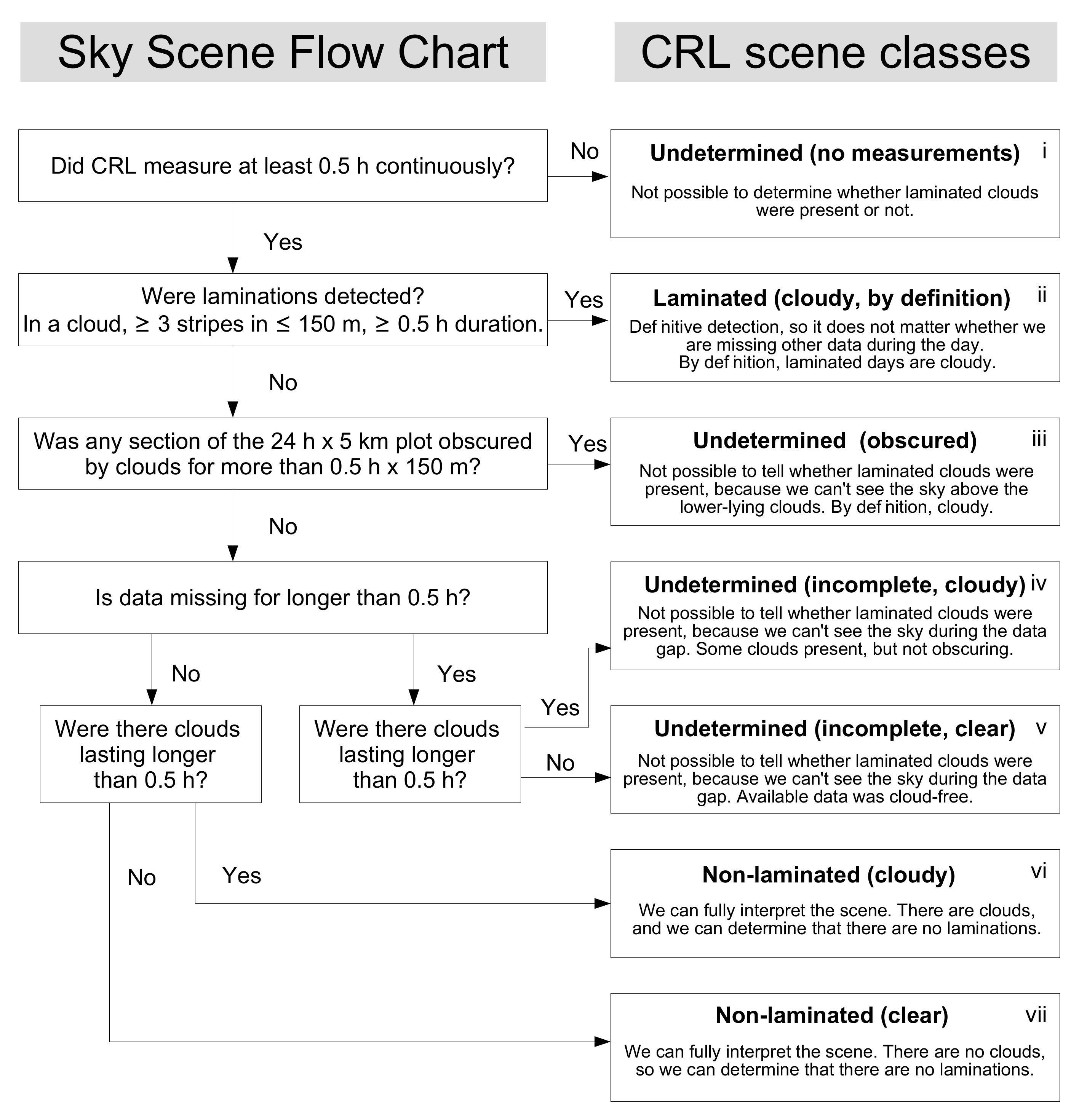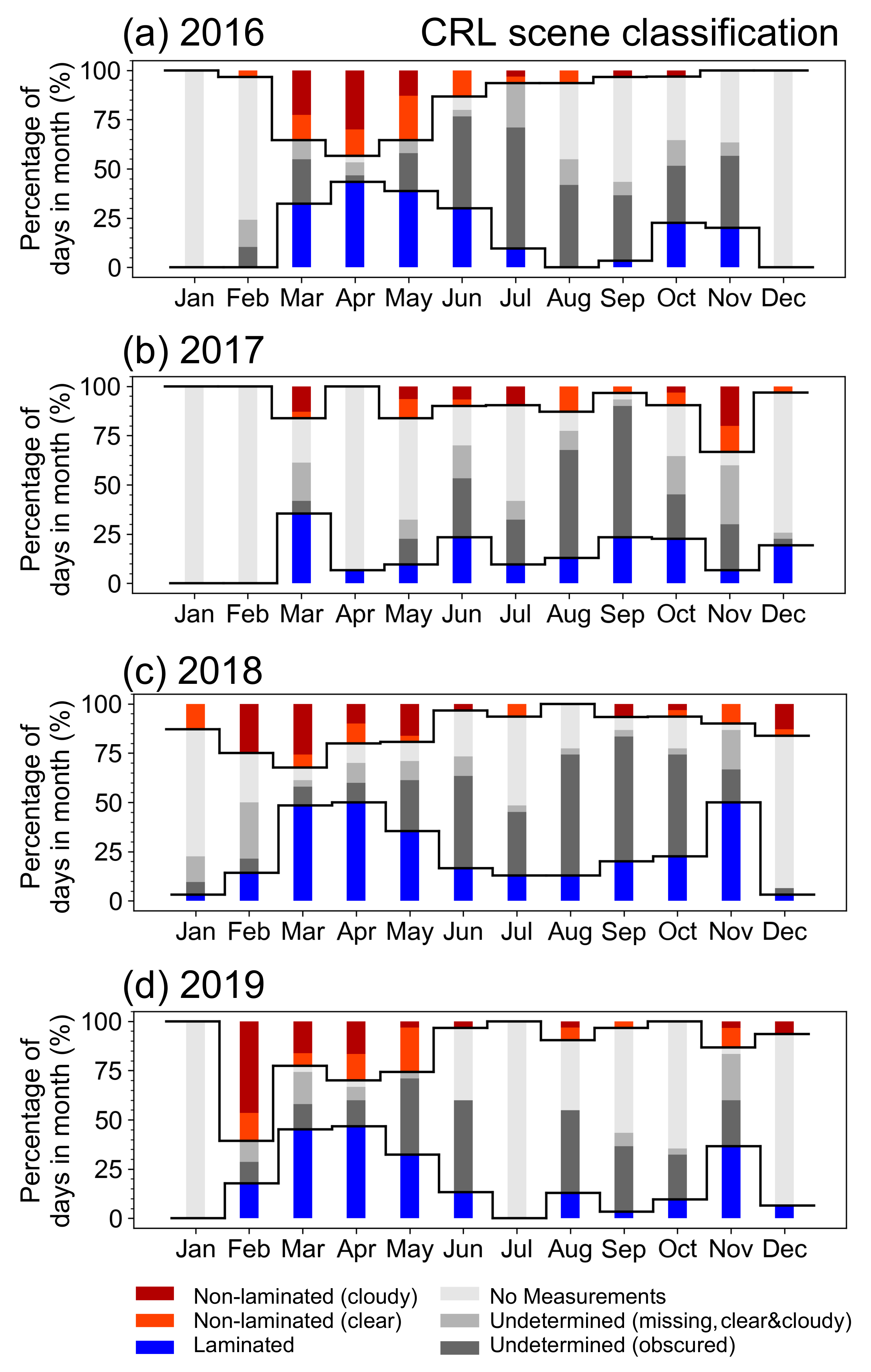The Relationship between Clouds Containing Multiple Layers 7.5–30 m Thick and Surface Weather Conditions
Abstract
:1. Introduction
2. Materials and Methods
2.1. Instrumentation
2.1.1. CRL Lidar
2.1.2. Eureka Weather Station Meteorological Reports
2.2. Method: Lidar Classification of Sky Scenes
- Laminated (the day contains at least one cloud with at least one detection of layered features meeting the criteria in Figure 2).
- Non-laminated (the day clearly contains no layered features within any clouds, which may or may not be present; the entire day is measured with the LiDAR).
- Undetermined (no clouds with qualifying layered features were measured by CRL; however, due to measurement limitations, the presence of clouds containing laminated features on that day cannot be conclusively ruled out.)
2.2.1. Identification Criteria for Laminated Classification
- The laminated region occurs in a cloud and not only in a region of aerosol, dust, fog, etc. Defined edges of the cloud were visible, and the range-scaled signal value was higher than surrounding non-cloud values, by a factor of 10 or higher. Typical signal values are approximately mMHz.
- There are a minimum of three quasi-horizontal, high-signal stripes, about equal in thickness, stacked one on top of the other, with maximum total extent of 150 m from the lower edge of the first stripe to the upper edge of the third stripe.
- The laminated condition lasts for a minimum duration of 0.5 h.
2.2.2. Identification Criteria for Non-Laminated Classification
2.2.3. Identification Criteria for Undetermined Classification
2.3. Occurrence Frequency Calculations
2.4. ECCC Weather Report Categorization Method
2.5. Correlation of Laminations with Weather Reports
- The strict case, which only includes days for which we have definitive measurements in Laminated (class ii in Figure 2) and Non-laminated classes (vi, vii). All Undetermined days (i, iii, iv, v) are excluded from the strict correlation tests.
- The inclusive case, which additionally includes most Undetermined classes as though they were non-laminated (i.e. Laminated includes class ii, Non-laminated includes classes i, iii, iv, v, vi, vii). Days with no measurements (class i) remain excluded from consideration, even in the inclusive case.
3. Results
3.1. Yearly Classification of Sky Scenes
3.2. Monthly Classification of Sky Scenes
3.3. Correlations of Laminated Features with Weather Conditions
4. Discussion
4.1. Discussion of Sky Scene Classification
4.2. Discussion of Correlations with Precipitating Snow
5. Conclusions
Author Contributions
Funding
Institutional Review Board Statement
Informed Consent Statement
Data Availability Statement
- CRL data: A standardized set of range-scaled photocounts plots has been submitted to the Dataverse data repository https://doi.org/10.5683/SP2/ST9YSB, accessed on 30 November 2021 [23]. The associated .mat files contain time, altitude, and range-scaled signal values with which the reader may reproduce the plots at any colour scale or aspect ratio desired. A spreadsheet identifying the sky scene classification of each day is also provided. Further CRL measurement data is available upon request from corresponding author (e.mccullough@dal.ca).
- ECCC data is available at: https://climate.weather.gc.ca/historical_data/search_historic_data_e.html, last accessed on 6 June 2020. Search parameter used was: Station Name “Eureka”. The three links to station “Eureka A” all include data from dates applicable to this project. They link to sites with different Climate ID numbers, assigned by the Meteorological Service of Canada, and the weather observations for these sites are all made near the CRL Lidar. New Climate ID numbers are assigned when stations discontinue a particular type of observations, even if other observations continue at the same location with the same site name. The three links are:
- -
- Climate ID 2401203: data from 2016 Feb 22 at 15:00 UTC through date last verified in June 2020; located at longitude: −85.81 W, 79.99 N.
- -
- Climate ID 2401208: no early February 2016 data, but also no weather recorded for most/all days; located at −85.81 W, 79.99 N. Not used for this paper.
- -
- Climate ID 2401200: data from January 2016 through February 25 at 12:00 UTC; located at −85.93 W, 79.98 N. This record has more frequent observations, but each record holds fewer values (e.g. the version from ID 2401203 may say “Blowing Snow, Fog” and have an entry only every 3 h, while ID 2401200 records something every hour but, for that particular entry, lists only “Blowing Snow”).
Acknowledgments
Conflicts of Interest
Appendix A. Supplementary Tables about Weather
| ECCC Reported | Number of Days | CRL Measurement |
|---|---|---|
| Weather Name | Reported | Days Only |
| Snow | 543 | 333 |
| Snow Grains | 5 | 2 |
| Snow Pellets | 3 | 3 |
| Snow Showers | 7 | 4 |
| Moderate Snow | 5 | 3 |
| Moderate Snow Grains | 1 | 1 |
| Blowing Snow | 285 | 148 |
| Rain | 124 | 65 |
| Rain Showers | 34 | 16 |
| Moderate Rain | 2 | 2 |
| Drizzle | 8 | 4 |
| Freezing Drizzle | 5 | 4 |
| Freezing Rain | 4 | 0 |
| Ice Crystals | 547 | 301 |
| Fog | 212 | 145 |
| Freezing Fog | 39 | 26 |
| Smoke | 1 | 0 |
| Haze | 1 | 0 |
| Blowing Sand | 1 | 1 |
| Dust | 2 | 1 |
| Ice Pellet Showers | 1 | 0 |
| Ice Pellets | 2 | 1 |
| Clear | 601 | 389 |
| Mainly Clear | 664 | 453 |
| Cloudy | 499 | 340 |
| Mostly Cloudy | 761 | 530 |
| No Value | 1447 | 906 |
References
- Nott, G.J.; Duck, T.J. Review lidar studies of the polar troposphere. Meteorol. Appl. 2011, 18, 383–405. [Google Scholar] [CrossRef]
- Intieri, J.M.; Shupe, M.D.; Uttal, T.; McCarty, B.J. An annual cycle of Arctic cloud characteristics observed by radar and lidar at SHEBA. J. Geophys. Res. 2002, 107, 5-1–5-15. [Google Scholar]
- Noel, V.; Chepfer, H.; Haeffelin, M.; Morille, Y. Classification of ice crystal shapes in midlatitude ice clouds from three years of lidar observations over the Sirta observatory. J. Atmos. Sci. 2006, 63, 2978–2991. [Google Scholar] [CrossRef] [Green Version]
- Cess, R.; Potter, G.; Blanchet, J.; Boer, G.J.; del Genio, A.; Deque, M.; Dymnikov, V.; Galin, V.; Gates, W.; Ghan, S.; et al. Intercomparison and interpretation of climate feedback processes in 19 atmospheric general circulation models. J. Geophys. Res. 1990, 95, 16601–16615. [Google Scholar] [CrossRef]
- Cess, R.D.; Zhang, M.H.; Ingram, W.J.; Potter, G.L.; Alekseev, V.; Barker, H.W.; Cohen-Solal, E.; Colman, R.A.; Dazlich, D.A.; Genio, A.D.D.; et al. Cloud feedback in atmospheric general circulation models: An update. J. Geophys. Res. Atmos. 1996, 101, 12791–12794. [Google Scholar] [CrossRef] [Green Version]
- Platt, C.; Young, S.; Manson, P.; Patterson, G.; Marsden, S.; Austin, R. The optical properties of equatorial cirrus from observations in the ARM pilot radiation observation experiment. J. Atmos. Sci. 1998, 55, 1977–1996. [Google Scholar] [CrossRef]
- Goosse, H.; Kay, J.E.; Armour, K.C.; Bodas-Salcedo, A.; Chepfer, H.; Docquier, D.; Jonko, A.; Kushner, P.J.; Lecomte, O.; Massonnet, F.; et al. Quantifying climate feedbacks in polar regions. Nat. Commun. 2018, 9, 1919. [Google Scholar] [CrossRef] [PubMed]
- Korolev, A.; McFarquhar, G.; Field, P.; Franklin, C.; Lawson, P.; Wang, Z.; Williams, E.; Abel, S.; Axisa, D.; Borrmann, S.; et al. Mixed-Phase Clouds: Progress and Challenges. Meteorol. Monogr. 2017, 58, 5.1–5.50. [Google Scholar] [CrossRef]
- Mioche, G.; Jourdan, O.; Ceccaldi, M.; Delanoë, J. Variability of mixed-phase clouds in the Arctic with a focus on the Svalbard region: A study based on spaceborne active remote sensing. Atmos. Chem. Phys. 2015, 14, 2445–2461. [Google Scholar] [CrossRef] [Green Version]
- Verlinde, J.; Harrington, J.Y.; McFarquhar, G.M.; Yannuzzi, V.T.; Avramov, A.; Greenberg, S.; Johnson, N.; Zhang, G.; Poellot, M.R.; Mather, J.H.; et al. The mixed phase Arctic cloud experiment. Bull. Am. Meteorol. Soc. 2007, 88, 205–211. [Google Scholar] [CrossRef] [Green Version]
- Verlinde, J.; Rambukkange, M.P.; Clothiaux, E.E.; McFarquhar, G.M.; Eloranta, E.W. Arctic multilayered, mixed-phase cloud processes revealed in mullimeter-wave cloud radar Doppler spectra. J. Geophys. Res. 2013, 118, 199–13213. [Google Scholar] [CrossRef]
- Rambukkange, M.; Verlinde, J.; Eloranta, E.; Luke, E.; Kollias, P.; Shupe, M. Fine-scale horizontal structure of Arctic mixed-phase clouds. In Proceedings of the American Meteorological Society’s 12th Conference on Cloud Physics, Madison, WI, USA, 10–14 July 2006. Number BNL-79883-2008-CP. [Google Scholar]
- McCullough, E.M.; Drummond, J.R.; Duck, T.J. Lidar measurements of thin laminations within Arctic clouds. Atmos. Chem. Phys. 2019, 19, 4595–4614. [Google Scholar] [CrossRef] [Green Version]
- Nott, G.; Duck, T.; Doyle, J.; Coffin, M.; Perro, C.; Thackray, C.; Drummond, J.; Fogal, P.; McCullough, E.M.; Sica, R. A remotely operated lidar for aerosol, temperature, and water vapor profiling in the High Arctic. J. Atmos. Ocean. Technol. 2012, 29, 221–234. [Google Scholar] [CrossRef]
- McCullough, E.M. A New Technique for Interpreting Depolarization Measurements Using the CRL Atmospheric Lidar in the Canadian High Arctic. Ph.D. Thesis, The University of Western Ontario, London, ON, Canada, 2015. [Google Scholar]
- McCullough, E.M.; Sica, R.J.; Drummond, J.R.; Nott, G.; Perro, C.; Thackray, C.P.; Hopper, J.; Doyle, J.; Duck, T.J.; Walker, K.A. Depolarization calibration and measurements using the CANDAC Rayleigh–Mie–Raman lidar at Eureka, Canada. Atmos. Meas. Tech. 2017, 10, 4253–4277. [Google Scholar] [CrossRef] [Green Version]
- Shupe, M.D.; Walden, V.P.; Eloranta, E.; Uttal, T.; Campbell, J.R.; Starkweather, S.M.; Shiobara, M. Clouds at Arctic Atmospheric Observatories. Part I: Occurrence and Macrophysical Properties. J. Appl. Meteorol. Climatol. 2011, 50, 626–644. [Google Scholar] [CrossRef] [Green Version]
- Cohen, J. Statistical Power Analysis for the Behavioural Sciences, 2nd ed.; Lawrence Erlbaum Associates: Hillsdale, MI, USA, 1988. [Google Scholar]
- Kerzenmacher, T.E.; Walker, K.A.; Strong, K.; Berman, R.; Bernath, P.F.; Boone, C.D.; Drummond, J.R.; Fast, H.; Fraser, A.; MacQuarrie, K.; et al. Measurements of O3, NO2 and Temperature during the 2004 Canadian Arctic ACE Validation Campaign. Geophys. Res. Lett. 2005, 32, 1–5. [Google Scholar] [CrossRef] [Green Version]
- Adams, C.; Strong, K.; Batchelor, R.L.; Bernath, P.F.; Brohede, S.; Boone, C.; Degenstein, D.; Daffer, W.H.; Drummond, J.R.; Fogal, P.F.; et al. Validation of ACE and OSIRIS ozone and NO2 measurements using ground-based instruments at 80∘ N. Atmos. Meas. Tech. 2012, 5, 927–953. [Google Scholar] [CrossRef] [Green Version]
- Griffin, D.; Walker, K.A.; Conway, S.; Kolonjari, F.; Strong, K.; Batchelor, R.; Boone, C.D.; Dan, L.; Drummond, J.R.; Fogal, P.F.; et al. Multi-year comparisons of ground-based and space-borne Fourier transform spectrometers in the high Arctic between 2006 and 2013. Atmos. Meas. Tech. 2017, 10, 3273–3294. [Google Scholar] [CrossRef] [Green Version]
- Shupe, M.D. Clouds at Arctic Atmospheric Observatories. Part II: Thermodynamic Phase Characteristics. Am. Meteorol. Soc. 2011, 50, 645–661. [Google Scholar] [CrossRef]
- McCullough, E. Replication Data for: The Relationship between Clouds Containing Multiple Layers 7.5–30 m Thick and Surface Weather Conditions. 2021. Available online: https://dataverse.scholarsportal.info/dataset.xhtml?persistentId=doi:10.5683/SP2/ST9YSB (accessed on 20 October 2021). [CrossRef]






| Weather Category | ECCC Weather Conditions Included |
|---|---|
| Snow | snow, snow grains, snow pellets, snow showers, |
| moderate snow, moderate snow grains | |
| Blowing Snow | blowing snow |
| Rain | rain, rain showers, moderate rain, drizzle, |
| freezing drizzle, freezing rain | |
| Ice Crystals | ice crystals |
| Fog | fog |
| Freezing Fog | freezing fog |
| Excluded from study | blowing sand, clear, mainly clear, cloudy, mostly cloudy, |
| dust, haze, ice pellets, ice pellet showers, smoke, no value |
Publisher’s Note: MDPI stays neutral with regard to jurisdictional claims in published maps and institutional affiliations. |
© 2021 by the authors. Licensee MDPI, Basel, Switzerland. This article is an open access article distributed under the terms and conditions of the Creative Commons Attribution (CC BY) license (https://creativecommons.org/licenses/by/4.0/).
Share and Cite
McCullough, E.M.; Wing, R.; Drummond, J.R. The Relationship between Clouds Containing Multiple Layers 7.5–30 m Thick and Surface Weather Conditions. Atmosphere 2021, 12, 1616. https://doi.org/10.3390/atmos12121616
McCullough EM, Wing R, Drummond JR. The Relationship between Clouds Containing Multiple Layers 7.5–30 m Thick and Surface Weather Conditions. Atmosphere. 2021; 12(12):1616. https://doi.org/10.3390/atmos12121616
Chicago/Turabian StyleMcCullough, Emily M., Robin Wing, and James R. Drummond. 2021. "The Relationship between Clouds Containing Multiple Layers 7.5–30 m Thick and Surface Weather Conditions" Atmosphere 12, no. 12: 1616. https://doi.org/10.3390/atmos12121616
APA StyleMcCullough, E. M., Wing, R., & Drummond, J. R. (2021). The Relationship between Clouds Containing Multiple Layers 7.5–30 m Thick and Surface Weather Conditions. Atmosphere, 12(12), 1616. https://doi.org/10.3390/atmos12121616






